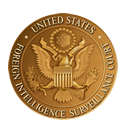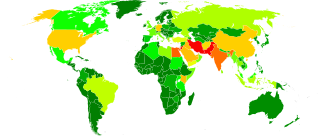Related Research Articles

The United States Foreign Intelligence Surveillance Court (FISC), also called the FISA Court, is a U.S. federal court established under the Foreign Intelligence Surveillance Act of 1978 (FISA) to oversee requests for surveillance warrants against foreign spies inside the United States by federal law enforcement and intelligence agencies.

The USA PATRIOT Act was a landmark Act of the United States Congress, signed into law by President George W. Bush. The formal name of the statute is the Uniting and Strengthening America by Providing Appropriate Tools Required to Intercept and Obstruct Terrorism Act of 2001, and the commonly used short name is a contrived acronym that is embedded in the name set forth in the statute.

Surveillance is the monitoring of behavior, many activities, or information for the purpose of information gathering, influencing, managing, or directing. This can include observation from a distance by means of electronic equipment, such as closed-circuit television (CCTV), or interception of electronically transmitted information like Internet traffic. Increasingly, governments may also obtain consumer data through the purchase of online information, effectively expanding surveillance capabilities through commercially available digital records. It can also include simple technical methods, such as human intelligence gathering and postal interception.
Computer and network surveillance is the monitoring of computer activity and data stored locally on a computer or data being transferred over computer networks such as the Internet. This monitoring is often carried out covertly and may be completed by governments, corporations, criminal organizations, or individuals. It may or may not be legal and may or may not require authorization from a court or other independent government agencies. Computer and network surveillance programs are widespread today and almost all Internet traffic can be monitored.

The Information Awareness Office (IAO) was established by the United States Defense Advanced Research Projects Agency (DARPA) in January 2002 to bring together several DARPA projects focused on applying surveillance and information technology to track and monitor terrorists and other asymmetric threats to U.S. national security by achieving "Total Information Awareness" (TIA).

Total Information Awareness (TIA) was a mass detection program by the United States Information Awareness Office. It operated under this title from February to May 2003 before being renamed Terrorism Information Awareness.
LexisNexis Risk Solutions is a global data and analytics company that provides data and technology services, analytics, predictive insights, and fraud prevention for a wide range of industries. It is headquartered in Alpharetta, Georgia, and has offices throughout the U.S. and in Australia, Brazil, China, France, Hong Kong, India, Ireland, Israel, the Philippines, and the United Kingdom.
Mass surveillance is the intricate surveillance of an entire or a substantial fraction of a population in order to monitor that group of citizens. The surveillance is often carried out by local and federal governments or governmental organizations, but it may also be carried out by corporations. Depending on each nation's laws and judicial systems, the legality of and the permission required to engage in mass surveillance varies. It is the single most indicative distinguishing trait of totalitarian regimes. It is often distinguished from targeted surveillance.
The Computer-Assisted Passenger Prescreening System (CAPPS) is a counter-terrorism system in place in the United States air travel industry that matches passenger information with other data sources. The United States Transportation Security Administration (TSA) maintains a watchlist, pursuant to 49 USC § 114 (h)(2), of "individuals known to pose, or suspected of posing, a risk of air piracy or terrorism or a threat to airline or passenger safety." The list is used to pre-emptively identify terrorists attempting to buy airline tickets or board aircraft traveling in the United States, and to mitigate perceived threats.
LexisNexis is an American data analytics company headquartered in New York, New York. Its products are various databases that are accessed through online portals, including portals for computer-assisted legal research (CALR), newspaper search, and consumer information. During the 1970s, LexisNexis began to make legal and journalistic documents more accessible electronically. As of 2006, the company had the world's largest electronic database for legal and public-records–related information. The company is a subsidiary of RELX.
DBT Online Inc., formerly known as Database Technologies, is a data mining company founded by Roy Brubaker and Hank Asher in 1992 in Las Vegas, Nevada, USA. It is today a subsidiary of US data aggregation group, ChoicePoint.
Harris Corporation was an American technology company, defense contractor, and information technology services provider that produced wireless equipment, tactical radios, electronic systems, night vision equipment and both terrestrial and spaceborne antennas for use in the government, defense, emergency service, and commercial sectors. They specialized in surveillance solutions, microwave weaponry, and electronic warfare. In 2019, it merged with L3 Technologies to form L3Harris Technologies.

The following are controversial invocations of the USA PATRIOT Act. The stated purpose of the Act is to "deter and punish terrorist acts in the United States and around the world, to enhance law enforcement investigatory tools, and for other purposes." One criticism of the Act is that "other purposes" often includes the detection and prosecution of non-terrorist alleged future crimes.
Counterintelligence Field Activity (CIFA) was a United States Department of Defense (DoD) agency whose size and budget were classified. The CIFA was created by a directive from the Secretary of Defense, then Donald Rumsfeld, on February 19, 2002. On August 8, 2008, it was announced that CIFA would be shut down. The Defense Intelligence Agency (DIA) absorbed most of the components and authorities of the CIFA into the Defense Counterintelligence and Human Intelligence Center, which was later consolidated into the Defense Clandestine Service.

Hank Asher was a businessman who founded several data fusion and data mining companies that compile information about companies, individuals and their interrelationships from thousands of different electronic databases. He was known by industry insiders as "the father of data fusion."
In the United States, fusion centers are designed to promote information sharing at the federal level between agencies such as the Federal Bureau of Investigation, the U.S. Department of Homeland Security, the U.S. Department of Justice, and state, local, and tribal law enforcement. As of February 2018, the U.S. Department of Homeland Security recognized 79 fusion centers. Fusion centers may also be affiliated with an emergency operations center that responds in the event of a disaster.

MAINWAY is a database maintained by the United States' National Security Agency (NSA) containing metadata for hundreds of billions of telephone calls made through the largest telephone carriers in the United States, including AT&T, Verizon, and T-Mobile.

American Civil Liberties Union v. Clapper, 785 F.3d 787, was a lawsuit by the American Civil Liberties Union (ACLU) and its affiliate, the New York Civil Liberties Union, against the United States federal government as represented by then-Director of National Intelligence James Clapper. The ACLU challenged the legality and constitutionality of the National Security Agency's (NSA) bulk phone metadata collection program.
Clearview AI, Inc. is an American facial recognition company, providing software primarily to law enforcement and other government agencies. The company's algorithm matches faces to a database of more than 20 billion images collected from the Internet, including social media applications. Founded by Hoan Ton-That and Richard Schwartz, the company maintained a low profile until late 2019, until its usage by law enforcement was first reported.
References
- ↑ , Privacy International, 5 June 2005, loaded 30 March 2007
- ↑ , Alternet, 16 October 2003, loaded 30 March 2007
- ↑ LexisNexis To Buy Seisint For $775 Million, Washington Post , 15 July 2004, loaded 2 April 2007
- ↑ requests
- ↑ Why We Should Fear The Matrix, ACLU
- ↑ Congressional testimony (25 March 2003) Archived 25 March 2004 at the Wayback Machine ,
- ↑ Commentaries Free Expression Policy Project
- ↑ First responders get homeland security network Archived 2004-04-07 at the Wayback Machine , Government Computer News, v. 23, #9, 28 April 2003